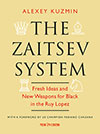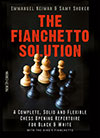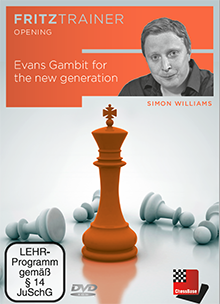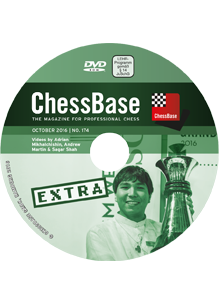
Black is Back!
What’s White’s Advantage Anyway?
by Andras Adorjan
New in Chess
http://www.newinchess.com/
319 pages
Price $ 22.95
ISBN: 978-90-5691-661-9
The well known GM Andras Adorjan provides the reader in this
book with a mass of Black wins,where nearly all of these games are
taken from his own
career, and that insures the reader from a wealth of super analyses and
enjoyable anecdotes.
As for example the story of the talented laszlo Antal, 1.e4 e5 2.d4
exd4 3.Qxd4 Nc6 4.Qe3 f5 5.exf5+ Be7 6.Bd3 Nf6 7.Ne2 0-0 8.0-0 d5 9.Nf4
Qd6
10.Re1 Ng4 11.Qf3 Nce5 12.Qxd5+ Qxd5 13.Nxd5 Bc5 14.Be3 Nxd3 15.cxd3
Bd6 16.h3 Ne5 17.d4 Nd3 18.Re2 Bxf5 19.b3 Rae8 20.Nd2 c6
21.Nc4 Bb8 22.Nc3 Re6 23.Rd1 Rg6 24.Kh1 b5 25.Nb2 Nxb2 26.Rxb2 b4
27.Na4 Be4 28.Rg1 Rf3 29.Rc1 Rxh3+ 30.Kg1 Bf3 0-1,Laszlo Antal – Andras
Jocha Hungary 1965.
But first some words from our author: The victim in the game was a
talented player, but did not become a professional. Forty years later,
he told me
why {half a bottle of whisky makes you sincere}”You know,when I
realized that chess can be played the way you played it,I saw no reason
to
hope for a shining future.
I sold my chess books the next day to a second-hand shop “{Ervin
Nagy become sad when he heard this story and
added “Unfortunately, mine too, which I have lent him.}”
Instead,Laszlo Aantal became a well known name in the circles of
European economists.
And that’s not the end of the story.We have a saying in Hungary: “Blood
doesn’t turn into water”. Today we have a grandmaster
called Gergely Antal – his son.
Many games in this book cover pages with text and analyses,a pet line
of the author is the move …g6.
There is even a Adorjan System 1.c4 g6 2.e4 e5 3.Nf3 Bg7 4.d4 exd4
5.Nxd4 Nf6!
With the idea 6.Nc3 0-0 7.Be2 Re8 8.f3 c6 9.Bg5 h6 10.Bh4 d5!
Readable are de the tributes to the contemporaries to Andras Adorjan,as
for example Lajos Portisch who started suddenly at the age of 50 a
singing career!
Conclusion: One of those chess books you must have read!

The Zaitsev System
Fresh Ideas and New Weapons for Black in the Ruy Lopez
by Alexey Kuzmin
New in Chess
http://www.newinchess.com/
255 pages
Price $ 26.95
ISBN: 978-90-5691-684-8
GM Alexey Kuzmin provides the reader in this book with a move to
move coverage of the Zaitsev System that runs with the moves: 1.e4 e5
2.Nf3 Nc6 3.Bb5 a6
4.Ba4 Nf6 5.0-0 Be7 6.Re1 b5 7.Bb3 d6 8.c3 0-0 9.h3 Bb7 10.d4 Re8.
There was a time that this opening lost some of it’s shine since Karpov
abandoned it as his defence in favour of the Caro-Kann but as we can
see in this work the Zaitsev Systen is back
and how!
Many modern lines as the Beliavsky/Morozevich 1.e4 e5 2.Nf3 Nc6 3.Bb5
a6 4.Ba4 Nf6 5.0-0 Be7 6.Re1 b5 7.Bb3 d6 8.c3 0-0 9.h3 Bb7 10.d4 Re8
11.Nbd2 Bf8 12.a4 Na5 13.Bc2 b4 14.d5 bxc3 15.bxc3 c6 16.c4 Qc7 17.Ra3
lead to sharp complicated positions that are very difficult to handle!
There was a time that White,could easy make a draw by repetition but
Kuzmin presents here in this book a new weapon based on a early
exchange
on d4,the so called Saratov Variation: 1.e4 e5 2.Nf3 Nc6 3.Bb5 a6 4.Ba4
Nf6 5.0-0 Be7 6.Re1 b5 7.Bb3 d6 8.c3 0-0 9.h3 Bb7 10.d4 Nd7
11.Nbd2 exd4 12.cxd4 Bf6 13.Nf1 Na5 14.Bc2 Re8
Black’s strategic is simple he wants to play c7-c5 and than
exchange on d4!
As we can see in this book white has a wide choice of options but black
gets a good position!
Covered in this book are the Kasparov Variation 12.a4,the Sochi
Variation 12.a3,Modern variation 12.d5,Geller/Karpov
Variation, rare variations and the so interesting Saratov
Variation,good for 254 impressive pages of text!
The introduction come from Fabiano Caruana and the great Igor Zaitsev
himself!
Conclusion:A very important referenence work on the Zaitsev System!
 The Fianchetto Solution
The Fianchetto Solution
A Complete, Solid and Flexible Chess
Opening Repertoire
by Emmanuel Neiman & Samy Shoker
New in Chess
http://www.newinchess.com/
267 pages
Price $ 22.95
ISBN: 978-90-5691-663-3
Grandmaster Samy Shoker and Emmanuel Neiman come here with a well
thought repertoire book based on the King’s Fianchetto,the first 182
pages are
completely divided to the black move g6.
Both authors have managed to create sparkling lines and excitement in
these black repertoire lines as for example 1.e4 g6 2.d4 Bg7 3.Nc3 c5!?
4.dxc5 Bxc3!? 5.bxc3 Nc6!
Or in the nearly forgotten Averbakh System where they manage to keep
the line with 1.d4 g6 2.c4 Bg7 3.Nc3 d6 4.e4 Nc6 playable
again, as for example 5.Be3 e5 6.d5 Nce7 7.c5 f5 8.Bb5+ Kf8 9.Nf3 Nf6
10.0-0 h6 11.Qb3 Kg8 12.Nxe5 dxe5 13.d6+ Kh7 14.dxe7 Qxe7
15.exf5 gxf5with an unbalanced position.
Even playable nowadays is Brodsky,Michail (2555) - Gritsayeva,Oksana
(2328) [A42]
RUS-chT blitz Sochi (10.24), 10.05.2015
1.d4 g6 2.c4 Bg7 3.e4 d6 4.Nc3 Nc6 5.Be3 e5 6.d5 Nd4 7.Nge2 Nxe2 8.Bxe2
Bh6 9.Qd2 Bxe3 10.Qxe3 Nf6 11.c5 0-0 12.0-0 Kg7
13.Rac1 a6 14.a4 Qe7 15.a5 Bg4 16.cxd6 cxd6 17.Na4 Bxe2 18.Qxe2 Rac8
19.Nb6 Rxc1 20.Rxc1 Nh5 21.g3 f5 22.exf5 Rxf5
23.Rc4 Rf7 24.Rc8 Qg5 25.Qc2 Nf6 26.Rc7 Ng4 27.Rxf7+ Kxf7 28.Qc8 Qf5
29.Qxf5+ gxf5 30.Nc8 Nf6 31.Nxd6+ Ke7
32.Nxf5+ Kd7 33.Ne3 Kd6 34.g4 Kc5 35.h4 Kb4 36.Kg2 Kxa5 37.Kf3 Kb6
38.g5 Nd7 39.h5 Kc5 40.Ke4 a5 41.h6 a4
42.Kf5 Nf8 43.Kxe5 b5 44.f4 b4 45.f5 b3 46.Nd1 Nd7+ 47.Ke6 Nb6 48.g6
1-0,even that black lost under pressure of time.
Pleasant to mention in this book are the alternative lines so there is
always a variation of your choice!
The remaining pages are divided to the typical fianchetto plans as for
example the following game from Bobby Fischer who frequently
used the King’s Indian Attack to launch a king side strike.
Fischer,Robert James - Geller,Uzi [C00]
Netanya-A Netanya (11), 29.06.1968
1.e4 e6 2.d3 d5 3.Nd2 c5 4.g3 Nf6 5.Bg2 Be7 6.Ngf3 0-0 7.0-0 Nc6 8.Re1
Qc7 9.e5 Nd7 10.Qe2 b5 11.h4 a5 12.Nf1 Nd4
13.Nxd4 cxd4 14.Bf4 Ra6 15.Nh2 Rc6 16.Rac1 Ba6 17.Bxd5 exd5 18.e6 Qd8
19.exd7 Re6 20.Qg4 f5 21.Qh5 Qxd7 22.Nf3 g6
23.Qh6 Bf6 24.Rxe6 Qxe6 25.Be5 Bxe5 26.Re1 f4 27.Rxe5 Qd7 28.h5 fxg3
29.hxg6 gxf2+ 30.Kxf2 hxg6 31.Qxg6+ Qg7 32.Rg5 1-0.
The aim of this book lays by the ambitious club player but I would like
to recommend it to all lover of the King’s Fianchetto!
Included are a large amount of self test to see if you have understood
the strategies of the fianchetto.
By the way this book gives me the same feeling as the works from Keene
en Botterill did in the early 70s!
Conclusion: A master work of
creativity!

The Spanish Fianchetto
by Sam Collins
http://www.chessbase.com
E-Mail info@chessbase.com
Price Euro 29.90
System requirements:Pentium-Processor
at 300 Mhz or higher, 64 MB RAM,
Windows XP, Windows
Vista, Windows 7, DVD drive, mouse, soundcard
The well known Sam Collins does not only explain the secrets of the
Spanish Fianchetto,but also provides the user of this DVD with a well
made and timeless black repertoire line.
This all is well packed in 19 heavy loaded video and good for around 4
hours and 10 minutes.
Some authors as for example Glenn Flear in his book Offbeat Spanish
call it The Smyslov Variation,but seen the popularity of the move 1.e4
e5 2.Nf3 Nc6
3.Bb5 g6 and success of the great Magnus Carlsen we can probably better
speak of the Spanish Fianchetto.
Now a days it has become more than a simple sideline,a fine example of
the power of this line is
1.e4 e5 2.Nf3 Nc6 3.Bb5 g6 4.c3 a6 5.Ba4 d6 6.d4 Bd7 7.0-0 Bg7 8.Re1
Nf6 9.d5 Ne7 10.Bxd7+ [10.c4 0-0 11.Nc3 Bg4
12.h3 Bc8 13.b4 Nh5 14.Bd2 a5 15.a3 (15.bxa5 Rxa5 16.Bb3 b6÷)
15...f5 (15...Kh8 16.c5 f5÷ 1-0 (75) Karjakin,S
(2779)-Ivanchuk,V (2769)
Astana 2012) ] 10...Nxd7 11.Be3 [11.a4 h6 12.c4 a5 13.b3 f5 14.Nc3 Nc5
15.Ba3 b6÷ (15...fxe4 ½-½ (56) Bologan,V
(2681)-Atalik,S (2593)
Loo 2013 EXT 2014 [Atalik,S]) ;
11.c4 h6 12.Nc3 f5 13.b4 0-0 14.a4 Nf6 15.Nd2 c6 16.a5 cxd5 17.cxd5 Rc8
18.Qb3 0-1 (38) Tabatabaei,M (2353)-Sandipan,C (2603)
Doha 2014 18...h5 intending ...Bh6] 11...Ng8!? [11...f5 12.Ng5
Nf8 13.exf5 gxf5 14.f4² 0-1 (45) Balogh,C (2660)-Sandipan,C (2603)
Germany 2015;
11...h6 12.Nfd2 f5 13.f3 Bf6 14.Bf2² 1-0 (42) Karjakin,S
(2772)-Sasikiran,K (2660) Tromsoe 2013 CBM 156 [Pavlovic,M]] 12.c4 Bh6
13.Nc3 Bxe3 14.Rxe3 Ngf6 15.b4 0-0 16.Rc1 Qe7 17.Nd2 a5! 18.a3 axb4
19.axb4 Nb6 20.h3 Rfc8" ½-½ (31) Karjakin,S
(2769)-Carlsen,M (2844) Wijk aan Zee 2016.
Included is a extra model file with over 860 entries!
Conclusion: IM Sam Collins provides the black player of this DVD with
awful strong repertoire!
 Evans Gambit for the new
generation
Evans Gambit for the new
generation
by Simon Williams
http://www.chessbase.com
E-Mail info@chessbase.com
Price Euro 29.90
System requirements:Pentium-Processor
at 300 Mhz or higher, 64 MB RAM,
Windows XP, Windows
Vista, Windows 7, DVD drive, mouse, soundcard
The famous English grandmaster Simon Williams provides the used of this
DVD with a modern approach of the famous Evans Gambit.
There was a time that the Evans Gambit was hailed as a gift from the
gods.
The inventor William Davies Evans 1790-1872 was the captain of a packet
boat in the postal service, playing between Wales and Ireland.
As we can see in these impressive 4 hours 26 minutes the Evans has
stood the test of time but I am still pleased to see some classic
model games as Evans,William Davies - McDonnell,Alexander [C51]
London London, 1829
1.e4 e5 2.Nf3 Nc6 3.Bc4 Bc5 4.b4 Bxb4 5.c3 Bc5 6.0-0 Nf6 7.d4 exd4
8.cxd4 Bb6 9.e5 d5 10.exf6 dxc4 11.Re1+ Kf8 12.Ba3+
Kg8 13.d5 Na5 14.Be7 Qd7 15.fxg7 Kxg7 16.Qd2 Qg4 17.Qc3+ Kg8 18.Qxh8+
Kxh8 19.Bf6+ Qg7 20.Re8# 1-0.
A more modern approach is Socko,Bartosz (2616) -
Mastrovasilis,Athanasios (2513) [D37]
GRE CupT final 32nd Porto Rio (1.3), 04.07.2014
1.e4 e5 2.Nf3 Nc6 3.Bc4 Bc5 4.b4 Bxb4 5.c3 Bc5 6.d4 exd4 7.0-0 d3 8.Ng5
Ne5 9.Nxf7 Nxf7 10.Bxf7+ Kxf7 11.Qh5+ g6 12.Qxc5 1-0.
Included is a extra database of 50 entries where I found the following
beauty: Sveshnikov,Vladimir (2186) - Stefansson,Hannes (2549) [C51]
Liepajas Rokade Liepaja (7), 31.07.2004
[Lukacs]
1.e4 e5 2.Nf3 Nc6 3.Bc4 Bc5 4.b4 Bxb4 5.c3 Be7 6.d4 Na5 7.Nxe5 [7.Be2
d6 (7...exd4 - Short-Onischuk,Tan Chin Nam Cup 2000 CBM 78) 8.Qa4+ a)
8.0-0?! This quiet developing move is not forceful enough. 8...exd4
9.Qxd4 (9.cxd4 Nf6) 9...Nf6 and Black can finish his development
without beeing disturbed. 10.Ba3 0-0 11.c4 c5 12.Qd3 Be6 13.Nfd2 Nd7
14.Nc3 Ne5 15.Qg3 Bh4 16.Qe3 Bxc4-+ Zawadzka-Zayac, Wisla Hugart op
1999; b) 8.dxe5 dxe5 9.Qa4+ c6 - 8.£a4; c) 8.Ba3 The most natural
reply is 8...Nc6! (8...c6?! leaves the ¤ on a5. 9.Bb4 .
£a4(9.Qa4 b5 10.Qc2 Qc7 11.Nbd2 Nf6 12.Bb4 Nb7 White has no real
compensation for the sacrificed §. 13.c4 a5 14.Bc3 b4 15.Bb2 exd4
16.Bxd4 c5 17.Bb2 a4 18.Rb1 (Alexander-Euwe, Maastricht 1946) 18...0-0!
19.0-0 (19.e5 dxe5 20.Bxe5 Qd8µ) 19...Ng4µ (19...Nh5!?) ) )
; 8...c6 9.dxe5 dxe5 10.Nxe5 Nf6 Black gave back the §, but he can
finish his development. 11.0-0 b5 (11...0-0 looks satisfactory for
Black. 12.Rd1 Qc7 13.Bf4 b5 14.Qc2 Qb7 (14...Bd6?! is strongly met by
15.Rxd6! Qxd6 16.Ng6 Qd8 17.Nxf8 Qxf8 18.a4² ) 15.Nd2 Be6 White
has weaknesses on the «. 16.a4 Qb6 17.axb5 cxb5 18.Rdb1 a6 19.Be3
Qc7 20.Bd4 Rfd8³ × c3, Hesse-Mottas, Pizol op 1997.) 12.Qc2
0-0÷ - Jobava-Stefansson, Antalya 2004 CBM 101] 7...Nxc4 8.Nxc4
d5 [8...d6!? 9.0-0 Nf6] 9.exd5 Qxd5 10.Ne3 Black has the , but White
can build up a strong § ". 10...Qd7!? Now the £ can prepare
the push b7-b5 and ¦d8 may also come. [10...Qd8 11.0-0 a)
Forcing matters by 11.Qa4+ leads nowhere after 11...c6 12.d5 Bd7 13.Qd4
Bf6 14.Qb4 b6 (14...cxd5!? 15.Qxb7 (15.Nxd5 Bc6) 15...Be6 16.Qc6+ Kf8
17.Ba3+ Ne7 18.0-0 Rc8) 15.0-0 Ne7=;
b) 11.Ba3 Nf6 (11...Bxa3 12.Nxa3 Nf6) 12.0-0 - 11.0-0(12.Qa4+!? c6
13.0-0 0-0 14.Re1 (14.Nd2!? Re8=) 14...Re8 15.Nd2 Be6 16.Rab1 Qc7
17.Bxe7 Rxe7 18.c4 This is the § structure White is aiming for,
the question is whether Black can successfully attack it or not.
18...Rd7!? b1) 18...b6 19.Nf3 c5 20.Qa3 (20.d5?! Bd7 21.Qc2 Ne4³)
20...Rae8 21.dxc5 bxc5 22.Red1 h6 ¹23.h3² (23.Rbc1
(Sveshnikov-Short, GER-chT 1992) 23...Bg4!² Sveshnikov) ; b2)
18...b5!? 19.cxb5 cxb5 20.Qxb5 Bxa2 21.Nf5²; 19.Nf3 b6 20.Rbd1
Rad8 (20...Ng4) 21.d5!?f) ; 11...Nf6 12.c4 a) 12.Qd3?! 0-0 13.c4
(13.Nf5 Bxf5 14.Qxf5 Qd5!³) 13...c6 14.Nc3 Bd6! . ¥c7-b6 in
order to put extra pressure on × d4. 15.Bd2 Re8 16.Rae1 Bc7!
17.f4 Bb6 18.d5 (18.Nc2? Rxe1 19.Rxe1 g6!; 18.Ne2 Ng4!) 18...Ng4!
(18...Ne4?! 19.Nxe4 (19.Kh1?! Nxd2 20.Qxd2 Bd7 21.f5 Qg5 22.Ncd1 Re4
23.Qc3 Bc5µ Mikhalchishin-Lukacs, Pernik 1976) 19...Bf5 20.Qc3
(20.Qa3 Bxe3+ 21.Rxe3 Rxe4=) 20...Bxe4 21.c5 cxd5 22.cxb6 d4 23.Qb3
dxe3 24.Bxe3 axb6=) 19.Kh1 (19.h3 Bf5!-+; 19.Na4 Bf5) 19...Bxe3!
20.Bxe3 Qh4 21.h3 Bf5 22.Qd2 (22.Qxf5 Nxe3 23.Qd7 Qg3!) 22...Nf6=;
b) 12.Ba3 White wants to liquidate the . 12...0-0 13.Bxe7 Qxe7 14.c4
(14.Nd2 Rd8) 14...c5 (14...b6 15.Nc3 (15.Qf3 Ba6 16.Nc3 Rfe8) 15...Bb7
16.Qc2 Qd7 (16...Rfe8 17.Rad1 Rad8=) 17.Rfd1 Rfe8 18.d5 Re5 19.Rd4 Rae8
20.h3 a6 securing the blockading square d6. (20...Bc8?! 21.Rad1 Rg5
22.Rh4 (Sveshnikov-Budimir, Ljubljana op 1999) 22...Rge5=) 21.Rad1
Qd6÷) 15.d5 Re8 (15...Ne4!?) 16.Nd2 Qd6 trying to blockade the
vital d6 square.;
c) 12.Re1 0-0÷; d) 12.Qf3 0-0 13.Rd1 Re8 (13...c6 14.c4 Bd7
looks a bit passive. 15.Nc3 Qa5 16.Bb2 Ba3! 17.Bxa3 Qxa3 18.Rd3
(V.Georgiev-Musat, Balkan-chT 1994) 18...Rfe8 19.Rad1 Qe7 20.h3 (20.d5?
immediately founders on tactics: 20...Bg4!-+) 20...Rac8 21.d5 b6²)
14.Nd2 c6 15.Bb2 Qa5 16.c4÷ Ivkovic-Sofrevsky, YUG-ch 1959;
12...0-0 13.Nc3 (13.Bb2 c6 14.Nc3 - 13.¤c3(14.Qf3 Re8÷;
14.Nd2 Re8 15.Qc2 Ng4 16.Nf5 Bg5 17.Nf3 Qf6 18.Ng3 Qh6 19.Bc1 Bxc1
20.Raxc1 Be6= Novosak-Shurygin, Frydek Mistek op 1996) ) 13...c6 a)
13...c5!? 14.Ncd5!? (14.d5 Ne8 Black can successfully blockade ×
d6. 15.Bb2 (15.Ne4 f5! 16.d6! otherwise Black gets a total control over
the dark squares. (16.Nd2 Bf6 17.Rb1 Nd6³) 16...Bxd6 17.Nxd6
(17.Qd5+ Kh8 18.Nxc5 (18.Nxd6 Qxd6µ) 18...Qc7µ (18...f4
19.Nc2 Rf5 20.Nxb7 Qc7) ) 17...Qxd6 18.Nd5 Be6³) 15...Nd6 16.Qd3
f5 (16...Re8 17.Rfe1 Bf6) 17.f4 Bf6 18.Ncd1 (18.Rad1 Re8) 18...Bxb2
19.Nxb2 Qf6 20.Qc2 Bd7 21.Rae1 Qd4 22.Rf3 Rae8÷
Sveshnikov-Nikolov, 1999) ;
b) 13...Re8 14.Bb2 (14.Rb1 Bf8) 14...Bf8 15.d5 a5! . ¦a6 16.Qf3
Ra6 17.h3 h5!? 18.Rad1 h4 19.Rfe1 Nd7 . ¤e5, ¦g6 Nikitin;
c) 13...Be6!? provoking the threat? 14.d5 Bd7 15.Qd4 b6 16.a4 Bc5
17.Qd3 Qe7 18.Re1 Rfe8 19.Bd2 Qe5÷ Lenz-Kalsch, cr 1988; 14.Rb1
a) 14.Bb2 Qa5 a1) 14...Bd6!? 15.Qf3!?² . ¦ad1; a2)
14...b5!? Black radically wants to solve the problem of the ". 15.cxb5
(15.Qf3 Rb8²) 15...cxb5 16.Qf3 (16.Nxb5? founders on 16...Rb8
17.Qe2 Qb6 18.a4 a6 19.Nc4 Qe6!-+) 16...Rb8 17.d5 Bc5! 18.Rad1 Qd6
19.h3 (19.Ne2 Bxe3²) 19...Re8 20.Rfe1 (20.Ne2 Nd7! 21.Nf5 (21.Nd4
Ne5) 21...Ne5=) 20...Bd7 21.Nf5 (21.Ne2 Ne4 22.Nd4 g6 23.Nc6
Rbc8÷) 21...Bxf5 22.Qxf5 (22.Rxe8+ Rxe8 23.Qxf5 a6=) 22...Rxe1+
23.Rxe1 a6 (23...Bd4 24.Rd1!² Nunn-Lukacs, Budapest 1978) 24.Ne4
Nxe4 25.Qxe4 Rd8 and the cannot be worse for Black. 26.Rd1
(26.Qe8+ Rxe8 27.Rxe8+ Qf8 28.Rxf8+ Kxf8; 26.Qg4 Qg6 27.Qxg6 hxg6
28.Rd1 f6=) 26...Qg6 27.Qxg6 hxg6 28.Kf1 f6 29.Ke2 Kf7=; 15.d5 Ba3
otherwise the ¥ on the long ' can be strong. 16.Bxa3 Qxa3 17.Qb3
Qa5 18.Rab1 h6 19.Qb4 Qxb4 20.Rxb4 c5 21.Rb2 b6 22.Rd1 Rd8 23.f3 Ne8
Black can blockade the defended þ. 24.a4 Nd6 25.Ra1 (25.Nb5 Kf8)
25...f5!? 26.Nb5 f4 27.Nxd6 Rxd6 28.Nf1 Bf5 29.a5 Re8 30.Kf2 Bd3=
Harding-Skotorenko, 1988;
b) 14.d5!? Re8 15.Qf3 b1) 15.Rb1?! Bd6! 16.Qf3 cxd5 17.Nexd5 Nxd5
18.cxd5 Qc7 The can even be better for Black in view of his
strong and the possibility of creating a remote þ. 19.h3
(19.Nb5? Bxh2+ 20.Kh1 Qc4 21.Kxh2 Qxf1 22.Nc7 Re1 23.Nxa8 Qh1+ 24.Kg3
Rg1! 25.Rb3 Qh3+ 26.Kf4 Qh6+-+ Tronhjem-van Perlo, cr 1995) 19...Bh2+
(19...Bd7) 20.Kh1 Be5÷; b2) 15.Bb2 Bd6÷; 15...Qc7 16.Bb2
Bd7 17.Rac1 Bd6 18.h3 c5÷ Hoiberg -Foisor, Debrecen EU-chT 1992;
14...Re8 (14...Qc7 15.Qf3 Re8 16.h3 Bd7 17.Bb2 -
14...¦e8(17.Nf5?! Bxf5 18.Qxf5 Rad8 19.Be3 (Achermann-de Jong,
corr 1994) 19...b6) ) 15.Bb2 Qc7 16.Qf3 Bd6!? (16...Bd7 17.Ne2 Rad8
(17...Bd6) 18.Ng3 Bc8 19.d5 cxd5 20.cxd5 Qa5 21.Rfd1 Qa6
22.Ngf5± (22.Rbc1 Ba3 23.Bxf6 Qxf6 24.Qxf6 gxf6 25.Rc4²
Kasparov-Short, London 1993) ) 17.h3 Bd7 18.Rfe1 (18.Ne2? If White
forgets about the " Black will conquer it... 18...Ne4! 19.Rfd1 Re6
20.d5 Ng5 21.Qh5 Rg6 22.dxc6 Qxc6 23.Nd4 Qe4³ Kasparov-Short,
London 1993) 18...Rad8÷;
10...Qa5 fighting against ¥a3 11.0-0 Nf6 12.c4 (12.Re1 Be6 13.c4 c6
14.Nd2 (14.Bb2 Rd8 15.d5 0-0 16.Nc3 Rfe8÷) 14...Rd8 15.Nb3 Qc7
16.Qf3 0-0 17.Bb2 Rfe8 18.Rac1 Bc8 19.d5 White can advance, but this
also creates some weaknesses in his camp. 19...h6 20.Nd4 Bd6! 21.dxc6
Bxh2+ 22.Kh1 Be5= Sigurjonsson-Frey, Reykjavik 1982) ¹12...0-0
(12...c6 13.d5 (13.Bb2 Be6 14.Nc3 Rd8 (14...0-0-0 15.d5!?f) 15.d5
0-0÷ (15...cxd5?! activates only the enemy pieces. 16.Ncxd5 Nxd5
17.cxd5 0-0 (17...Bxd5? 18.Qh5!+-) 18.Qf3± Cafferty-Van Geet,
Amsterdam 1972) ) 13...Qd8 14.Qf3 cxd5 15.cxd5 0-0 16.Na3 Re8 (16...Ne8
17.Nac4 Nd6 18.Bb2² Sveshnikov-Kharitinov, RUS-ch Krasnoyarsk
2003) 17.Nac4 Bc5÷) 13.d5 (13.Bb2 c6 (13...Qg5 14.Nd2 Ng4 15.Nd5
Bd6 16.Nf3 Qh5 17.h3 c6 18.Nc3 Nf6 19.Ne5 Qh4÷ Fries
nielsen-H.W.Jensen, Copenhagen op 1994) 14.d5 cxd5 15.cxd5 Rd8 16.Nc3
Qb4!= Brynell-Perez, Malmo op 1986/87) 13...b5!? a) 13...Rd8 14.Bb2
(14.Bd2 Bb4) 14...b6 15.Qf3²; b) 13...c6 14.d6!? (14.Qb3 cxd5
15.cxd5 Rd8 16.Nc3 Ng4"; 14.Bd2 Qc7÷) 14...Bd8 15.Bb2 Re8;
14.Nd2 Rd8 (14...bxc4? helps only for White to finish his development.
15.Ndxc4 Qa6 16.Bb2± Timman-Tatai, Amsterdam 1977) 15.Nb3 Qb6
16.Nd4 Bb7 (16...bxc4 17.Nc6 Re8 18.Nxc4 Qb5 19.Ne3) 17.Rb1 a6 18.Nef5
(18.Bb2 Bc5 19.Ndf5) 18...Bc5 19.Be3 c6 (19...g6!? 20.Nh6+ Kg7÷)
20.Qf3 cxd5 21.cxb5² Canda-Sieiro Gonzales, Camaguey 1986] 11.0-0
Nf6 12.c4 [12.d5 0-0 13.c4 - 12.c4;
12.Bb2 0-0 13.c4 - 12.c4] 12...0-0 [12...b5!?] 13.Bb2 [13.d5
b5!?÷ is Black's main idea here.(13...c6 14.Nc3 - 13.¤c3;
13...Ng4?! 14.Bb2 Bc5 15.Bd4 Bxd4 16.Qxd4 Re8 17.Nc3 Nxe3 18.fxe3 Qe7
19.Rf3² Minasian-Giorgadze, Manila op (Men) 1992) ;
13.Qd3 is also met by the standard 13...b5! 14.cxb5 a6! 15.Nc3 axb5
16.Qxb5 (16.Nxb5? Ba6) 16...Qxd4!÷;
¹13.Nc3 against the quick b7-b5 looks best. 13...c6!? (13...b6!?
14.a4 . ¥a3 (14.d5 c6) 14...Bb7÷) 14.d5! cxd5 15.Ncxd5 Nxd5
16.Nxd5 Bd8 17.Rb1 White's active pieces compensate the worse §
structure and the . 17...Qc6 18.Qd4 Be6 19.Rb3 Rc8! 20.Ba3 Re8 21.Rg3
f6 22.Nxf6+ Bxf6 23.Qxf6² Nunn-Larsen, Phillips Drew 1980]
13...b5!? Black wants to ruin White's § " and open the diagonals
for the . [13...c6 14.Nd2 Ng4 15.Re1 Nxe3 16.Rxe3 Bg5 17.Rb3 Re8 18.Nf3
Bf6= Marusenko-Podat, Independence Cup 2002] 14.Nc3 [14.Nd2 Bb7 15.Qb3
a6 16.a4 Rab8 17.axb5 axb5 18.cxb5 Bd5 19.Nxd5 Nxd5 20.Nc4 Rxb5=
Skotorenko-Krogius, SU 1969;
14.cxb5 Qxb5 15.Ba3 (Perez-Kabuye, Novi Sad ol (Men) 1990) 15...Bxa3
16.Nxa3 Qa6=] 14...bxc4 15.Nxc4 [15.Re1 Rb8 16.Nxc4 Bb7 -
15.¤c4] 15...Rb8 16.Re1 Bb7 Here we see the bright side of
10...£d7, the ¥ belongs to the long '. 17.Qc2 Rfe8 18.Rad1
Bb4 [18...Qg4 19.Ne3 Qh5³] 19.Rxe8+ [19.Ne5 Qe6³] 19...Rxe8
20.Ne5 Qe6 21.Ne2?! This gives up the vital × d5 without a fight.
[21.Qa4 Bxc3 22.Bxc3 Nd5³] 21...Nd5 22.Ng3 Nf4 23.f3 f6 24.Qxc7
Ba6! 25.Ng4??
4r1k1/p1Q3pp/b3qp2/8/1b1P1nN1/5PN1/PB4PP/3R2K1 b - - 0 0
allowing the nice finish. [25.Nf5 Bf8 26.d5 Nxd5µ;
25.d5 Nxd5µ] 25...Qe1+! [25...Qe1+ 26.Rxe1 Rxe1+ 27.Kf2 Nd3#] 0-1
Highly recommend are the 14 interactive self tests.
Conclusion: One of those super made
ChessBase DVD’s!

ChessBase Magazine
extra issue 174 Extra
October 2016
Videos by Adrian Mikhalchishin, Andrew Martin & Sagar
Shah
ChessBase
http://www.chessbase.com
E-Mail
info@chessbase.com
ISSN 1432-8992
Euro 12.99
System requirements:
Minimum: Pentium III 1 GHz, 1 GB RAM, Windows Vista, XP
(Service Pack 3), DirectX9 graphic card with 256 MB RAM, DVD-ROM drive,
Windows Media Player 9, ChessBase 12/Fritz 13 or included Reader and
internet connection for program activation. Recommended: PC Intel Core
i7, 2.8 GHz, 4 GB RAM, Windows 8.1 or Windows 10, DirectX10 graphic
card (or compatible) with 512 MB RAM or better, 100% DirectX10
compatible sound card, Windows Media Player 11, DVD-ROM drive and
internet connection for program activation.
ChessBase Magazine Extra issue 174 comes with a Hugh amount of
27.459 games ,all played between August and October of this year.
My favourite Latvian Gambit game of this month is: Richter,Rudolf
(1262) - Thoreux Josso,Aaron (1124) [C40]
EU-ch U10 26th Prague (5), 22.08.2016
1.e4 e5 2.Nf3 f5 3.Nxe5 Qf6 4.d4 d6 5.Nc4 fxe4 6.Nc3 Qg5 7.Ne3 Nc6
8.Be2 Nf6 9.Bd2 Nxd4 10.Ned5 Qxg2 11.Rf1 Bh3
12.Nxc7+ Kd8 13.Qc1 Nxe2 14.Kxe2 Bg4+ 15.Ke1 Bh3 16.Ke2 Qf3+ 17.Ke1
Bxf1 0-1.
Again there are some superb made video files as Adrian
Mikhalchishin who shows you a Ruy Lopez game in which he
outplayed Anna
Muzychuk with the good old Cozio Variation.
Sagar Shah shows us a game by Mikhail Botvinnik and Andrew
Martin goes back in time with the legendary Bobby Fischer.
Conclusion: This is must have
material!






